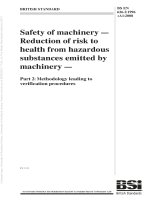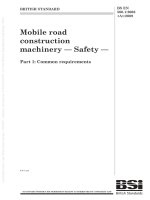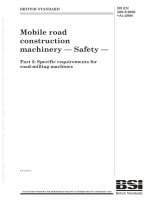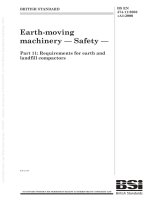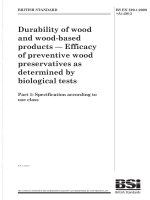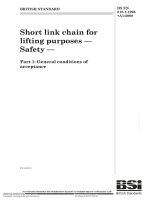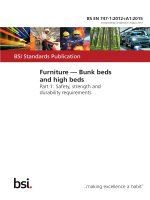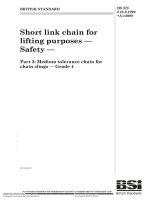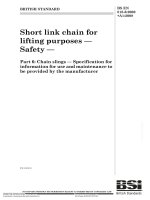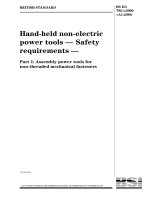Bsi bs en 00626 1 1994 + a1 2008
Bạn đang xem bản rút gọn của tài liệu. Xem và tải ngay bản đầy đủ của tài liệu tại đây (438.05 KB, 18 trang )
Licensed copy: University of Auckland Library, University of Auckland Library, Version correct as of 08/05/2012 17:54, (c) The British Standards Institution 2012
BRITISH STANDARD
Safety of machinery —
Reduction of risks to
health from hazardous
substances emitted by
machinery —
Part 1: Principles and specifications for
machinery manufacturers
ICS 13.110
BS EN
626-1:1994
+A1:2008
Licensed copy: University of Auckland Library, University of Auckland Library, Version correct as of 08/05/2012 17:54, (c) The British Standards Institution 2012
BS EN 626-1:1994+A1:2008
National foreword
This British Standard is the UK implementation of EN 626-1:1994+A1:2008. It
supersedes BS EN 626-1:1994 which is withdrawn.
The start and finish of text introduced or altered by amendment is indicated in
the text by tags. Tags indicating changes to CEN text carry the number of the
CEN amendment. For example, text altered by CEN amendment A1 is
indicated by !".
The UK participation in its preparation was entrusted to Technical Committee
MCE/3, Safeguarding of machinery.
A list of organizations represented on this committee can be obtained on
request to its secretary.
This publication does not purport to include all the necessary provisions of a
contract. Users are responsible for its correct application.
Compliance with a British Standard cannot confer immunity from
legal obligations.
This British Standard was
published under the authority
of the Standards Board
and comes into effect on
15 May 1995
© BSI 2008
ISBN 978 0 580 60965 7
Amendments/corrigenda issued since publication
Date
Comments
30 November 2008
Implementation of CEN amendment A1:2008 and
alignment of BSI and CEN publication dates
Licensed copy: University of Auckland Library, University of Auckland Library, Version correct as of 08/05/2012 17:54, (c) The British Standards Institution 2012
EUROPEAN STANDARD
EN 626-1:1994+A1
NORME EUROPÉENNE
EUROPÄISCHE NORM
June 2008
ICS 13.110
Supersedes EN 626-1:1994
English Version
Safety of machinery - Reduction of risks to health from
hazardous substances emitted by machinery - Part 1: Principles
and specifications for machinery manufacturers
Sécurité des machines - Réduction des risques pour la
santé résultant de substances dangereuses émises par des
machines - Partie 1 : Principes et spécifications à l'intention
des constructeurs de machines
Sicherheit von Maschinen - Reduzierung des
Gesundheitsrisikos durch Gefahrstoffe, die von Maschinen
ausgehen - Teil 1: Grundsätze und Festlegungen für
Maschinenhersteller
This European Standard was approved by CEN on 6 September 1994 and includes Amendment 1 approved by CEN on 18 May 2008.
CEN members are bound to comply with the CEN/CENELEC Internal Regulations which stipulate the conditions for giving this European
Standard the status of a national standard without any alteration. Up-to-date lists and bibliographical references concerning such national
standards may be obtained on application to the CEN Management Centre or to any CEN member.
This European Standard exists in three official versions (English, French, German). A version in any other language made by translation
under the responsibility of a CEN member into its own language and notified to the CEN Management Centre has the same status as the
official versions.
CEN members are the national standards bodies of Austria, Belgium, Bulgaria, Cyprus, Czech Republic, Denmark, Estonia, Finland,
France, Germany, Greece, Hungary, Iceland, Ireland, Italy, Latvia, Lithuania, Luxembourg, Malta, Netherlands, Norway, Poland, Portugal,
Romania, Slovakia, Slovenia, Spain, Sweden, Switzerland and United Kingdom.
EUROPEAN COMMITTEE FOR STANDARDIZATION
COMITÉ EUROPÉEN DE NORMALISATION
EUROPÄISCHES KOMITEE FÜR NORMUNG
Management Centre: rue de Stassart, 36
© 2008 CEN
All rights of exploitation in any form and by any means reserved
worldwide for CEN national Members.
B-1050 Brussels
Ref. No. EN 626-1:1994+A1:2008: E
BS EN 626-1:1994+A1:2008
Licensed copy: University of Auckland Library, University of Auckland Library, Version correct as of 08/05/2012 17:54, (c) The British Standards Institution 2012
EN 626-1:1994+A1:2008 (E)
Contents
Page
Foreword..............................................................................................................................................................3
Introduction .........................................................................................................................................................4
1
Scope ......................................................................................................................................................4
2
Normative references ............................................................................................................................4
3
Definitions ..............................................................................................................................................5
4
Risk assessment....................................................................................................................................5
5
Types of emissions................................................................................................................................7
6
Requirements and/or measures for elimination and/or reduction of risk........................................9
7
Information for use and maintenance................................................................................................10
8
Verification of the safety requirements and/or measures ...............................................................10
Annex A (informative) Examples of measures for the reduction of exposure to hazardous
substances ...........................................................................................................................................11
Annex ZA (informative) !Relationship between this European Standard and the Essential
Requirements of EU Directive 98/37/EC"
" .......................................................................................13
Annex ZB (informative) !Relationship between this European Standard and the Essential
Requirements of EU Directive 2006/42/EC"
" ...................................................................................14
Bibliography ......................................................................................................................................................15
2
BS EN 626-1:1994+A1:2008
Licensed copy: University of Auckland Library, University of Auckland Library, Version correct as of 08/05/2012 17:54, (c) The British Standards Institution 2012
EN 626-1:1994+A1:2008 (E)
Foreword
This document (EN 626-1:1994+A1:2008) has been prepared by Technical Committee CEN/TC 114 “Safety of
machinery”, the secretariat of which is held by DIN.
This European Standard shall be given the status of a national standard, either by publication of an identical
text or by endorsement, at the latest by December 2008, and conflicting national standards shall be withdrawn
at the latest by December 2008.
This document includes Amendment 1, approved by CEN on 2008-05-18.
This document supersedes EN 626-1:1994.
The start and finish of text introduced or altered by amendment is indicated in the text by tags ! ".
!Part 2 of this standard deals with the methodology of verification procedures."
This document has been prepared under a mandate given to CEN by the European Commission and the
European Free Trade Association, and supports essential requirements of EC Directive(s).
!For relationship with EC Directive(s), see informative Annexes ZA and ZB, which are integral parts of this
document."
The Annex A is informative and contains "Examples of measures for the reduction of exposure to hazardous
substances", Annex B is informative and contains a "Bibliography".
According to the CEN/CENELEC Internal Regulations, the national standards organizations of the following
countries are bound to implement this European Standard: Austria, Belgium, Bulgaria, Cyprus, Czech
Republic, Denmark, Estonia, Finland, France, Germany, Greece, Hungary, Iceland, Ireland, Italy, Latvia,
Lithuania, Luxembourg, Malta, Netherlands, Norway, Poland, Portugal, Romania, Slovakia, Slovenia, Spain,
Sweden, Switzerland and United Kingdom.
3
BS EN 626-1:1994+A1:2008
Licensed copy: University of Auckland Library, University of Auckland Library, Version correct as of 08/05/2012 17:54, (c) The British Standards Institution 2012
EN 626-1:1994+A1:2008 (E)
Introduction
This standard has been produced to assist designers, manufacturers and other interested bodies to interpret
the essential safety requirements in order to achieve conformity with European Legislation on machinery
safety.
This is one of a programme of standards produced by CEN/CENELEC under mandates from CEC and EFTA.
This programme has been divided into several categories to avoid duplication and to develop a logic which will
enable rapid production of standards and easy cross reference between them.
The hierarchy of standards is as follows:
a)
Type A standards (generic safety standards) giving basic concepts, principles for design, and general
aspects that can be applied to all machinery;
b)
Type B standards (group safety standards) dealing with one safety aspect or one type of safety related
device that can be used across a wide range of machinery:
Type B1 standards on particular safety aspects (e.g. safety distances, surface temperature, noise,
etc.);
c)
Type B2 standards are safety related devices (e.g. two hand controls, interlocking devices, pressure
sensitive devices etc.);
Type C standards (machine safety standards) giving detailed safety requirements for a particular
machine or group of machines defined in the scope of the standard.
This is a type B1 standard and its primary purpose is to give guidance to the writers of type C standards when
machines are identified as having hazardous substances as a significant risk. This standard may also be used
as guidance in controlling the risk where there is no type C standard for a particular machine.
1
Scope
This European Standard deals with principles for the control of risks to health due to hazardous substances
from machinery. This European Standard is not applicable to hazardous substances which are a hazard to
health solely because of explosive, flammable, high or low temperature, high or low pressure or radioactive
properties.
2
Normative references
This European Standard incorporates by dated or undated reference, provisions from other publications.
These normative references are cited at the appropriate places in the text and the publications are listed
hereafter. For dated references, subsequent amendments to or revisions of any of these publications apply to
apply to this European Standard only when incorporated in it by amendment or revision. For undated
references the latest edition of the publication referred to applies.
EN 292-1, Safety of machinery, basic concepts, general principles for design — Part 1: Basic terminology,
methodology.
EN 292-2, Safety of machinery, basic concepts, general principles for design — Part 2: Technical principles
and specifications.
4
BS EN 626-1:1994+A1:2008
Licensed copy: University of Auckland Library, University of Auckland Library, Version correct as of 08/05/2012 17:54, (c) The British Standards Institution 2012
EN 626-1:1994+A1:2008 (E)
prEN 626-2, Safety of machinery, reduction of risks to health from hazardous substances emitted by
machinery – Part 2: Methodology leading to verification procedures.
3
Definitions
For the purposes of this standard, the following definitions apply:
3.1
intended use
see EN 292-1
3.2
hazardous substances
any chemical or biological agent which is hazardous to health, e.g. substances or preparations classified
as 1).
Very toxic;
Toxic;
Harmful;
Corrosive;
Irritant;
Sensitising;
Carcinogenic;
Mutagenic;
Teratogenic;
Pathogenic;
Asphyxiants;
4
Risk assessment
4.1 An identification of hazards and assessment of the foreseeable risks from substances hazardous to
health shall be made by the machinery manufacturer. This shall cover, as far as it is possible, any potential
personal exposures arising from the machine at any stage in its life.
NOTE
Details of the methodology of the risk assessment are given in EN 292-1.
4.2 The level of risk depends on the hazardous properties of the substances, the likelihood that personal
exposure will occur and the degree of exposure. The health effects of hazardous substances may be:
1)
Short or long term;
For EEC countries see also 67/548/EEC and its amendments
5
BS EN 626-1:1994+A1:2008
Licensed copy: University of Auckland Library, University of Auckland Library, Version correct as of 08/05/2012 17:54, (c) The British Standards Institution 2012
EN 626-1:1994+A1:2008 (E)
4.3
Reversible or irreversible.
Hazardous substances can be in any physical state (gases, liquids, solids) and can affect the body by:
Inhalation;
Ingestion;
Contact with the skin, eyes and mucous membranes;
Penetration through the skin.
4.4
The hazardous substances may arise from:
Any part of a machine;
Substances present in the machine;
Material arising directly or indirectly from articles and/or substances processed by the machine or used on
the machine.
4.5
The stages in the life of a machine may include (see also EN 292-1):
Construction;
Transport and commissioning;
6
Transport;
Installation;
Commissioning;
Use;
Operation, including starting up and shutting down;
Failure;
Setting or process changeover;
Cleaning;
Adjustment;
Maintenance and repair;
De-commissioning, dismantling and, as far as safety is concerned, disposal.
BS EN 626-1:1994+A1:2008
Licensed copy: University of Auckland Library, University of Auckland Library, Version correct as of 08/05/2012 17:54, (c) The British Standards Institution 2012
EN 626-1:1994+A1:2008 (E)
5
Types of emissions
5.1
Airborne emissions
5.1.1 Airborne emissions can be significant sources of exposure to hazardous substances. Inhalation is
usually the most significant of all the routes of entry (see 4.3). In addition, airborne emissions may enter the
body by the other routes particularly when substances are deposited on surfaces of the body or when they are
ingested.
5.1.2
Airborne emissions may arise from various sources including:
Machining, e.g. sawing, grinding, sanding, milling;
Evaporation and thermal convection e.g. open tanks, crucibles, solvent baths;
Hot metal processes e.g. welding, brazing, soldering, profile cutting, casting;
Material handling e.g. hopper charging, pneumatic conveying, sack filling;
Spraying e.g. painting, high-pressure cleaning;
Leaks e.g. at pump seals, flanges;
By-products and effluents e.g. gases from drosses, rubber vulcanisation fumes;
Maintenance e.g. emptying filter bags;
Dismantling processes e.g. breaking lead batteries, stripping asbestos insulation;
Combustion of fuel e.g. internal combustion engine exhausts;
Apparatus for mixing food;
Metal working e.g. nitrosamines from water soluble metal working lubricants.
5.1.3
Some examples of airborne hazardous substances are as follows:
Respiratory irritants e.g. sulphur dioxide, chlorine, cadmium fume;
Sensitisers e.g. isocyanates, enzymes, colophon fumes;
Carcinogens e.g. asbestos, chromium VI, benzene, vinyl chloride monomer;
Fibrogenic dusts e.g. free crystalline silica, asbestos, cobalt;
Asphyxiants e.g. nitrogen, argon, methane;
Biological agents e.g. Legionella pneumophila, dusts from mouldy hay;
Substances which affect specific parts of the body e.g. mercury (nerve system, kidney); lead (nerve
system, blood); carbon tetrachloride (nerve system, liver); carbon monoxide (blood).
7
BS EN 626-1:1994+A1:2008
Licensed copy: University of Auckland Library, University of Auckland Library, Version correct as of 08/05/2012 17:54, (c) The British Standards Institution 2012
EN 626-1:1994+A1:2008 (E)
5.1.4 Airborne emissions may be subject to techniques of evaluation based on the measurement of
concentrations of substances in the breathing zone of the persons involved. The results of such
measurements are usually compared with suitable criteria.
5.1.5 There are many methods of sampling air and analysing the sample for airborne contaminants.
Sampling methods and analytical techniques should be selected according to the nature of the airborne
contaminant.
5.2
Non-airborne emissions
5.2.1 Non-airborne emissions can be significant sources of exposure to hazardous substances by ingestion,
contact with skin, eyes or mucous membranes or penetration through the skin (see 4.3).
5.2.2
Non-airborne emissions may arise from various circumstances including:
Migration from open sources e.g. splashing and evaporation/condensation leading to secondary
emissions;
Opening machinery e.g. for maintenance;
Entry into machinery e.g. for inspection;
Material handling e.g. charging, sampling, disposal;
Handling machinery parts e.g. dismantling;
Incorrect operation e.g. overfilling;
Leaks e.g. at pump seals, flanges;
Ruptures.
5.2.3 Exposure to non-airborne emissions can cause ill-health as a result of a variety of hazardous
properties associated with different materials. Some examples include:
Corrosives e.g. sulphuric acid;
Irritants e.g. wet cement;
Sensitisers e.g. chromium compounds, epoxy resins;
Carcinogens e.g. used quenching oil, beryllium oxide, polycyclic aromatic hydrocarbons;
Biological agents e.g. infected cutting oils, infected blood.
The ill-health produced may be local to the point of contact or the results of effects elsewhere in the body
(systemic or target organ). In some cases both situations may occur, e.g. phenol.
8
BS EN 626-1:1994+A1:2008
Licensed copy: University of Auckland Library, University of Auckland Library, Version correct as of 08/05/2012 17:54, (c) The British Standards Institution 2012
EN 626-1:1994+A1:2008 (E)
5.2.4 Non-airborne emissions cannot be evaluated by measurements of concentration of substances in the
air. Criteria based on these concentrations cannot be used. Other criteria may be established e.g. microbial
concentrations in cutting oils.
5.2.5 In some cases it can be relevant to carry out quantitative assessments of surface contamination. The
criteria to be applied should be based on both toxicological and practical considerations. Techniques for
measuring such contamination include:
Chemical analyses of wipes;
Use of fluorescent tracers;
Colorimetric indications;
Count of microorganism.
6
Requirements and/or measures for elimination and/or reduction of risk
Risks of exposure to hazardous substances shall be reduced as far as practical, taking into account scientific
and technical methods and limits relating to exposure and the external environment. In selecting the most
appropriate methods of reducing risks, the manufacturer shall take measures to reduce the risks of exposure
as close to the emission source as possible. The manufacturer shall apply the following principles, in the order
given taking into account the state of the art:
Design of machinery to eliminate or prevent risks of exposure;
Design of machinery to reduce risks that cannot be eliminated, in the following order of priority:
Reduction of emission;
Reduction by ventilation or other engineering means;
Reduction of exposure by machinery operation or segregation;
Information about the residual risks to the user and advice to the user on additional measures to reduce
exposure.
NOTE
A detailed list of possible measures is given in annex A.
9
BS EN 626-1:1994+A1:2008
Licensed copy: University of Auckland Library, University of Auckland Library, Version correct as of 08/05/2012 17:54, (c) The British Standards Institution 2012
EN 626-1:1994+A1:2008 (E)
7
7.1
Information for use and maintenance
Information for use
7.1.1 The manufacturer shall state in the instructions the intended uses of the machine, the hazardous
substances which can arise from the machine (see 4.4) and the operating procedures. The manufacturer shall
specify, when necessary, the level of competence to be achieved by training. The manufacturer shall give
appropriate details in the instructions where setting and operating conditions of the machine can result in a
reduction of risks.
7.1.2 When the machine is supplied with the means of reducing the risks to health the machinery
manufacturer shall supply information on its correct use and factors that may adversely affect its performance.
7.1.3 When there is no such provision of the means of reducing the risk to health, such methods of reduction
and/or testing which are suitable and proven shall be specified by the manufacturer.
7.1.4 If leaks, spills or uncontrolled releases of a hazardous substance can be foreseen, the manufacturer
shall provide information to limit the extent of risks to health and to regain adequate control as soon as
possible. The information should cover, where appropriate, emergency procedures, safe disposal of the
substance and suitable protective equipment to enable the source of release to be safely identified and repairs
to be made.
7.1.5 The manufacturer shall provide information on the necessary personal protective equipment and the
hygiene arrangements.
7.2
Information for maintenance
The machinery manufacturer shall provide sufficient instructions for the maintenance of the machine without
risk to health.
NOTE
This may include the necessary maintenance to ensure the continuing effective reduction of emissions of
hazardous substances. Implementation by the user may be achieved by a structured maintenance programme employing
various functional and performance checks at suitable intervals as far as applicable.
EXAMPLE
The elements of such a maintenance programme for the user of a mechanical vibrating screen may
include regular checks on:
The physical condition of the hardware, including screen covers; inspection hatches etc., required to
maintain the integrity of containment;
Gaskets and seals associated with covers and hatches to ensure that they are intact and functional;
Flexible connectors on feed and product lines to ensure that they are still connected and in good
condition;
Extraction ventilation, checks include visual checks, routine mechanical inspection and ventilation
performance testing;
The accumulation of material.
8
Verification of the safety requirements and/or measures
Methodology leading to verification procedures for the reduction of risks to health from hazardous substances
emitted by machinery is described in prEN 626-2.
10
BS EN 626-1:1994+A1:2008
Licensed copy: University of Auckland Library, University of Auckland Library, Version correct as of 08/05/2012 17:54, (c) The British Standards Institution 2012
EN 626-1:1994+A1:2008 (E)
Annex A
(informative)
Examples of measures for the reduction of exposure to hazardous
substances
These examples may either be incorporated into the machinery design or provided as information for the user.
A.1 Elimination and prevention of risks
Elimination of the operation that causes the emission;
Selecting an alternative production process;
Selecting alternative operations;
Elimination of the use of the substance;
Substitution of hazardous materials by less hazardous alternatives, e.g. cadmium free silver solder;
Totally enclosed processes and handling systems e.g. enclosed pumps;
Remote controlled and automated processes.
A.2 Reduction of risks
A.2.1 Reduction of emission
Use of vapour return systems e.g. piping displaced air to supply tank;
Use of dust reduced forms e.g. pellets, granules, flakes or pastilles instead of powders;
Enclosed material handling systems;
Dust suppression by wetting;
Maintenance of valves, pumps and flanges;
Prevention of spills and leaks;
Use of liquids which are dust free when dried out, e.g. anti-stick soap solution used on unvulcanized
rubber;
Immersion of shafts and seals of reactive liquids to absorb leaks of hazardous substances, e.g.
isocyanate pumps;
Fitting covers, flexible or rigid barriers or floating balls to contain emissions from e.g. conveyors, tanks;
Condensation of vapours, e.g. in solvent degreasing tanks;
11
BS EN 626-1:1994+A1:2008
Licensed copy: University of Auckland Library, University of Auckland Library, Version correct as of 08/05/2012 17:54, (c) The British Standards Institution 2012
EN 626-1:1994+A1:2008 (E)
Systems operated under negative pressure;
Process control, e.g. use of thermostats, pressure switches.
A.2.2 Reduction by ventilation
In most cases the descending order of effectiveness is:
Local exhaust ventilation from almost complete to partial enclosure;
Local exhaust ventilation without enclosure;
Air curtains;
General dilution ventilation, e.g. extraction with clean air inflow;
Ventilation by building design, e.g. hot processes in high buildings.
A.2.3 Information on reduction of exposure by management or segregation
Prohibition of non-essential access, e.g. to confined spaces or dangerous operations or high risk areas;
Separation of hazardous and non-hazardous operations, e.g. by partial enclosures, partitions or separate
buildings;
Reduction of the number of employees exposed to hazards, e.g. by multiskill training or more efficient
work practices;
Operation of processes from control rooms with visits to polluted areas only when needed;
Use of bund walls to prevent the spread of spillage;
Reduction of exposure time.
A.3 Information on residual risks and other measures
Regular cleaning or disinfection of contaminated walls, surfaces, etc.;
Provision of means for safe storage and disposal of substances hazardous to health;
Suitable personal protective equipment;
Prohibition of eating, drinking and smoking in contaminated areas;
Provision and maintenance of adequate facilities for washing, changing and storage of clothing, including
suitable arrangements for laundering contaminated clothing;
Adequate information, instruction and training for appropriate personnel.
12
BS EN 626-1:1994+A1:2008
Licensed copy: University of Auckland Library, University of Auckland Library, Version correct as of 08/05/2012 17:54, (c) The British Standards Institution 2012
EN 626-1:1994+A1:2008 (E)
Annex ZA
(informative)
!Relationship between this European Standard and the Essential Requirements of
EU Directive 98/37/EC
This European Standard has been prepared under a mandate given to CEN by the European Commission
and the European Free Trade Association to provide a means of conforming to Essential Requirements of the
New Approach Directive Machinery 98/37/EC, amended by 98/79/EC.
Once this standard is cited in the Official Journal of the European Communities under that Directive and has
been implemented as a national standard in at least one Member State, compliance with the normative
clauses of this standard given in Table ZA.1 confers, within the limits of the scope of this standard, a
presumption of conformity with the corresponding Essential Requirements of that Directive and associated
EFTA regulations.
Table ZA.1 — Correspondence between this European Standard and Directive 98/37/EC
Clause(s)/sub-clause(s) of this EN Essential Requirements (ERs) of Qualifying remarks/Notes
Directive 98/37/EC, amended by
98/79/EC
All clauses
Annex I, 1.5.13
Emission of dust, gases etc.
WARNING — Other requirements and other EC Directives may be applicable to the product(s) falling within
the scope of this standard."
13
BS EN 626-1:1994+A1:2008
Licensed copy: University of Auckland Library, University of Auckland Library, Version correct as of 08/05/2012 17:54, (c) The British Standards Institution 2012
EN 626-1:1994+A1:2008 (E)
Annex ZB
(informative)
!Relationship between this European Standard and the Essential Requirements of
EU Directive 2006/42/EC
This European Standard has been prepared under a mandate given to CEN by the European Commission
and the European Free Trade Association to provide a means of conforming to Essential Requirements of the
New Approach Directive Machinery 2006/42/EC.
Once this standard is cited in the Official Journal of the European Communities under that Directive and has
been implemented as a national standard in at least one Member State, compliance with the normative
clauses of this standard given in Table ZB.1 confers, within the limits of the scope of this standard, a
presumption of conformity with the corresponding Essential Requirements of that Directive and associated
EFTA regulations.
Table ZB.1 — Correspondence between this European Standard and Directive 2006/42/EC
Clause(s)/sub-clause(s) of this EN Essential Requirements (ERs) of Qualifying remarks/Notes
Directive 2006/42/EC
All clauses
Emissions of hazardous
materials and substances
WARNING — Other requirements and other EC Directives may be applicable to the product(s) falling within
the scope of this standard."
14
Annex I, 1.5.13
BS EN 626-1:1994+A1:2008
Licensed copy: University of Auckland Library, University of Auckland Library, Version correct as of 08/05/2012 17:54, (c) The British Standards Institution 2012
EN 626-1:1994+A1:2008 (E)
Bibliography
[1]
67/548/EEC Council Directive of 27 June 1967 on the approximation of laws, regulations on
administrative provisions relating to the classification, packaging and labelling of dangerous
substances
[2]
67/548/EEC announcement of the Commission according to article 2 of the decision 85/71/EEC of the
Commission of 21 December 1984 on the list of substances registered according to Council Directive
67/548/EEC of 27 June 1967 on the approximation of laws, regulations and administrative provisions
relating to the classification, packaging and labelling of dangerous substances.
15
Licensed copy: University of Auckland Library, University of Auckland Library, Version correct as of 08/05/2012 17:54, (c) The British Standards Institution 2012
BS EN
626-1:1994
+A1:2008
British Standards Institution (BSI)
BSI is the independent national body responsible for preparing
British Standards. It presents the UK view on standards in Europe and at the
international level. It is incorporated by Royal Charter.
Revisions
British Standards are updated by amendment or revision. Users of
British Standards should make sure that they possess the latest amendments or
editions.
It is the constant aim of BSI to improve the quality of our products and services.
We would be grateful if anyone finding an inaccuracy or ambiguity while using
this British Standard would inform the Secretary of the technical committee
responsible, the identity of which can be found on the inside front cover.
Tel: +44 (0)20 8996 9000 Fax: +44 (0)20 8996 7400
BSI offers members an individual updating service called PLUS which ensures
that subscribers automatically receive the latest editions of standards.
Buying standards
Orders for all BSI, international and foreign standards publications should be
addressed to Customer Services.
Tel: +44 (0)20 8996 9001 Fax: +44 (0)20 8996 7001
Email:
You may also buy directly using a debit/credit card from the BSI Shop on the
Website />In response to orders for international standards, it is BSI policy to supply the
BSI implementation of those that have been published as British Standards,
unless otherwise requested.
Information on standards
BSI provides a wide range of information on national, European and
international standards through its Library and its Technical Help to Exporters
Service. Various BSI electronic information services are also available which give
details on all its products and services. Contact the Information Centre.
Tel: +44 (0)20 8996 7111 Fax: +44 (0)20 8996 7048
Email:
Subscribing members of BSI are kept up to date with standards developments
and receive substantial discounts on the purchase price of standards. For details
of these and other benefits contact Membership Administration.
Tel: +44 (0)20 8996 7002 Fax: +44 (0)20 8996 7001
Email:
Information regarding online access to British Standards via British Standards
Online can be found at />Further information about BSI is available on the BSI website at
.
Copyright
BSI Group Headquarters
389 Chiswick High Road,
London W4 4AL, UK
Tel +44 (0)20 8996 9001
Fax +44 (0)20 8996 7001
www.bsigroup.com/standards
Copyright subsists in all BSI publications. BSI also holds the copyright, in the
UK, of the publications of the international standardization bodies. Except as
permitted under the Copyright, Designs and Patents Act 1988 no extract may be
reproduced, stored in a retrieval system or transmitted in any form or by any
means – electronic, photocopying, recording or otherwise – without prior written
permission from BSI.
This does not preclude the free use, in the course of implementing the standard,
of necessary details such as symbols, and size, type or grade designations. If these
details are to be used for any other purpose than implementation then the prior
written permission of BSI must be obtained.
Details and advice can be obtained from the Copyright & Licensing Manager.
Tel: +44 (0)20 8996 7070 Email:
